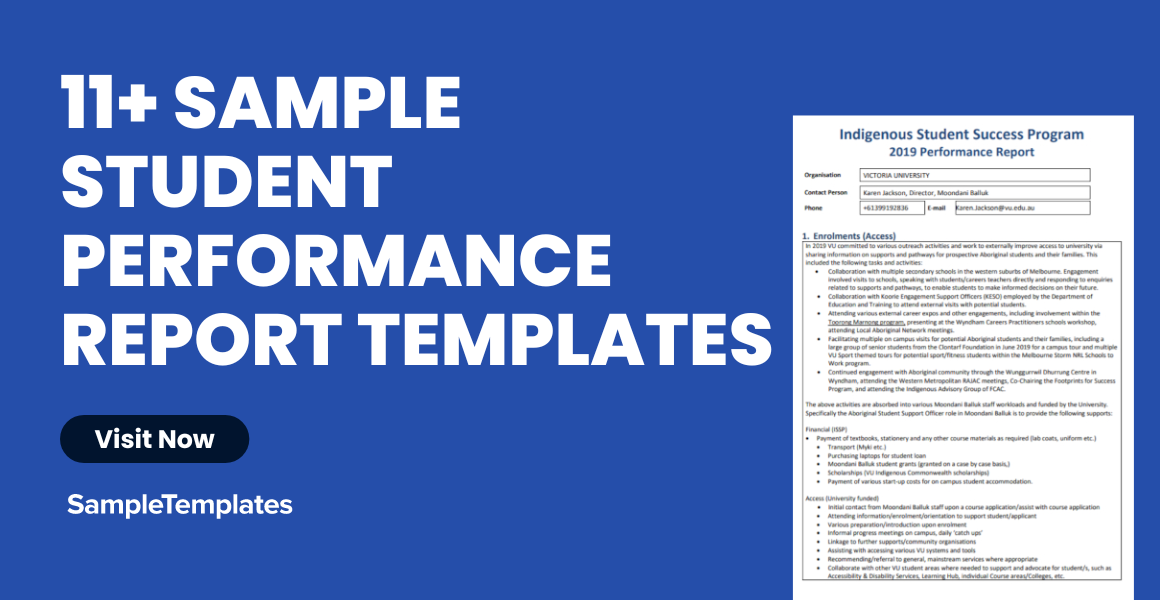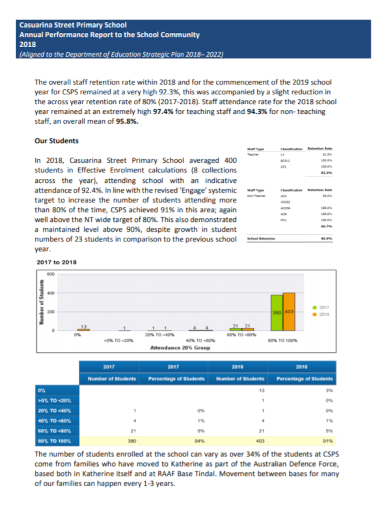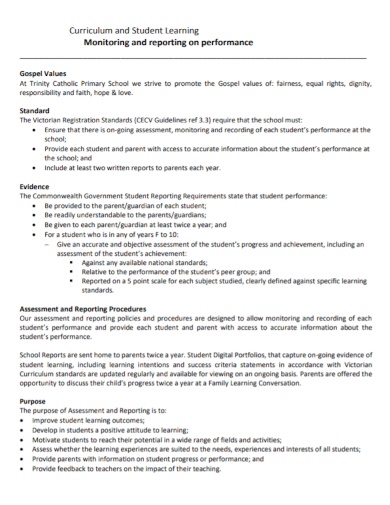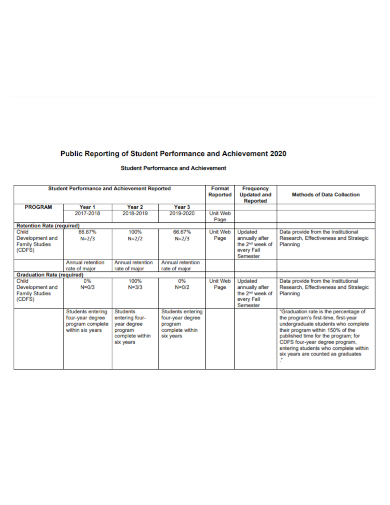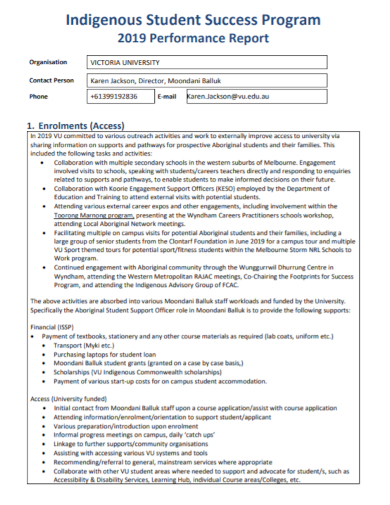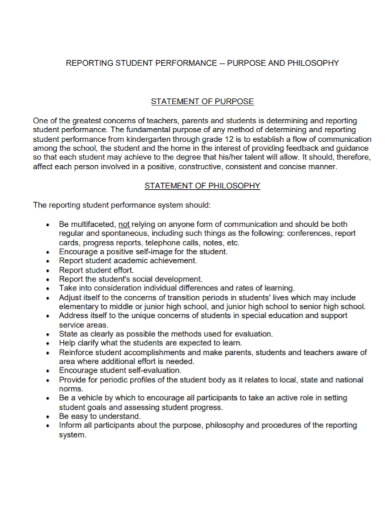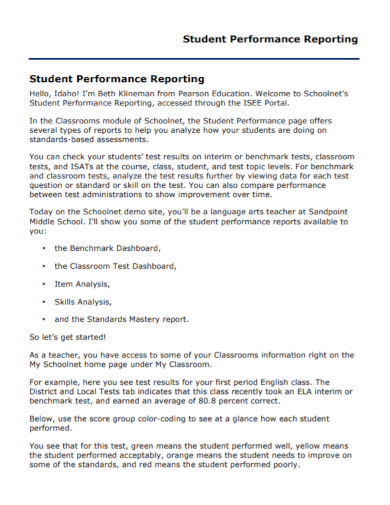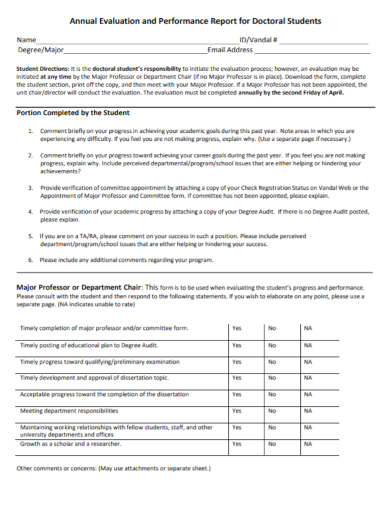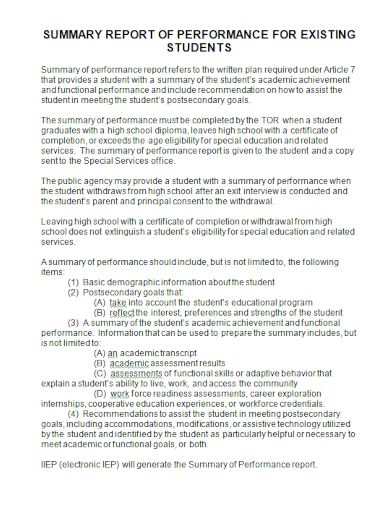Children are sent to school in order to learn and develop their skills and knowledge. To be able to monitor their growth and development, schools or universities provide student performance reports. These reports may be assessed along a variety of dimensions including class participation, individual written work on papers and exams, and group activities such as projects and presentations. To know more about this do continue to read this article and check out below our free student performance report samples.
11+ Student Performance Report Samples
1. Report On Students’ Performance Sample
2. Students Performance Report
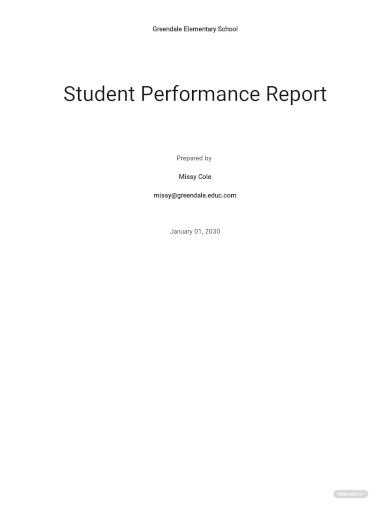
3. Student Performance Report Sample PDF
4. Student Class Performance Report
5. Students Performance Report Sample
How do you write a student’s progress report?
Writing a student’s progress report involves providing a comprehensive overview of their academic performance, behavior, and overall development. Here are steps to guide you:
- Introduction: Begin with a brief introduction, mentioning the student’s name, grade, and the period covered by the report.
- Academic Performance: Evaluate the student’s performance in each subject, highlighting strengths and areas for improvement. Use specific examples and assessments.
- Behavior and Participation: Comment on the student’s behavior, attitude, and level of participation in class. Note any improvements or concerns.
- Attendance and Punctuality: Include information about the student’s attendance and punctuality, emphasizing the importance of consistent attendance.
- Work Habits: Discuss the student’s work habits, including organization, time management, and completion of assignments.
- Social and Emotional Development: Address the student’s social and emotional development, considering factors such as interactions with peers, communication skills, and emotional well-being.
- Goals and Areas for Improvement: Set realistic goals for the student and identify specific areas for improvement. Offer suggestions for how they can enhance their performance.
- Positive Reinforcement: Acknowledge and celebrate the student’s achievements, both academically and behaviorally. Provide positive reinforcement to encourage continued effort.
- Parental Involvement: Encourage parental involvement by offering suggestions for how parents can support the student’s learning at home.
- Enclosures: If applicable, include any additional materials such as test scores, project assessments, or examples of the student’s work.
- Professional Tone: Maintain a professional and objective tone throughout the report, focusing on constructive feedback and support.
Remember to tailor the progress report to the individual student, providing specific and actionable feedback. Open communication with parents or guardians can further support the student’s progress.
6. Student Monitoring Performance Report Template
7. Student Academic Performance Report Sample
How do you check student performance?
Checking student performance involves a multifaceted approach that goes beyond traditional assessments. Here are various methods to assess and evaluate student performance:
- Formative Assessments: Regularly use quizzes, polls, short assignments, or class discussions to gauge understanding during the learning process.
- Summative Assessments: Conduct end-of-unit tests, final projects, or comprehensive exams to evaluate overall comprehension and mastery of the material.
- Class Participation: Observe and assess students’ engagement, contributions, and participation in class discussions and activities.
- Homework and Assignments: Evaluate the quality and completeness of homework assignments and projects, providing feedback for improvement.
- Peer Assessment: Encourage students to assess and provide feedback on each other’s work, fostering collaboration and diverse perspectives.
- Portfolios: Have students compile portfolios showcasing their best work, demonstrating progress and a holistic view of their abilities.
- Observations: Observe students during class activities, presentations, or group work to assess their skills, behavior, and interactions.
- Self-Assessment: Encourage students to reflect on their own learning, set goals, and assess their performance against predefined criteria.
- Standardized Tests: Administer standardized tests when necessary to measure academic achievement and compare students against national or regional benchmarks.
- Project-Based Assessments: Evaluate students based on real-world projects, assessing their ability to apply knowledge and skills in practical scenarios.
- Continuous Feedback: Provide ongoing feedback on assignments, tests, and classwork, emphasizing areas for improvement and recognizing achievements.
- Rubrics: Develop and use rubrics to establish clear criteria for grading, ensuring consistency and transparency in assessment.
- Online Platforms: Utilize educational technology and online platforms to track student progress, engagement, and performance in real-time.
- Individual Conferencing: Conduct one-on-one conferences with students to discuss their progress, address concerns, and set goals.
By employing a combination of these methods, educators can obtain a comprehensive understanding of each student’s performance, allowing for tailored support and fostering continuous improvement. It’s essential to use a mix of formative and summative assessments to provide a well-rounded evaluation of students’ knowledge, skills, and overall development.
8. Student Performance Report Example
9. Report Of Students Performance
10. Student Performance Example
11. Report About Students Performance
12. Student Performance Report Format
What Is a Student Performance Report?
A Performance Report in general is a document that defines addresses the outcome of an activity or the work of an individual. In an academic setting, Student Performance Report refers to the written sample plan that provides a student a summary of the student’s academic achievement and functional performance and include recommendation on how to assist the student in meeting their goals.
How Do You Write a Student Performance Report?
Evaluating what students have learned throughout the course can be accomplished in many ways, depending on the course objectives and how student performance will be measured. The structure of a report is very important to lead the reader through your thinking to a course of action or decision. Here are helpful tips for writing student performance reports:
1. Student Information
Student information is an important part performance report. Keep it simple by tracking only student names, or add other details about your students’ interests and preferences to help your tailor improvement plans as necessary. When you have the right student information in your form, it’s easy to follow their progress.
2. Purpose of the Performance Report
Inform all participants about the purpose, philosophy and procedures of the reporting system.
3. Student Progress
Regularly track a student’s progress to be able align this with his or her performance level. Analyze the student in terms of his or her academic skills, capabilities and attitude level. Record as well their academic achievements, student report and social development. In this way, teachers can determine which needs improvement and set up goals and action plans to help achieve them.
4. Propose Solutions for Student Progress
As mentioned, whatever the performance outcome teachers are due to propose sample recommendation for areas that the student’s need improvement. Simply tracking student progress is not enough, suggesting solutions for any areas of concern so you can aid your students in improving and evaluate how solutions are working.
How do you describe student performance?
Describing student performance involves several key steps. First, assess the student’s work objectively, considering both academic and non-academic aspects. Next, identify specific strengths and weaknesses, providing examples to illustrate each point. Use clear and concise language, avoiding vague statements. Tailor the description to the student’s individual progress and potential. Offer constructive feedback, emphasizing areas for improvement with actionable suggestions. Maintain a balanced and fair tone throughout the description. Incorporate relevant data, such as grades or assessment scores, to support your observations. Finally, conclude by highlighting overall achievements and expressing confidence in the student’s continued growth.
General FAQs
1. How do you write a good student report?
Write a good student report by providing a balanced assessment of academic performance, highlighting strengths and areas for improvement. Include specific examples, maintain clarity, and offer constructive feedback for future development.
2. What is an example of a student performance comment?
An example of a student performance comment could be: “Consistently demonstrates a strong work ethic and engages actively in class discussions. Exhibits commendable analytical skills and consistently produces high-quality assignments.”
3. What Is a Teacher Evaluation?
A Teacher Evaluation a procedure for reviewing the performance of a teacher in a classroom and analyzing the review to provide constructive sample feedback for the teacher’s professional growth and development.
4. What Is a Self-Appraisal?
A Self-Appraisal or Self Assessment is an evaluation of oneself. A good, thorough self-appraisal is one in which you are able to highlight your positives, but also honestly mention your points of weaknesses.
5. What Is a Student Performance Indicator?
A Student Performance Indicator are a means to focus on specific expectations of a sample program. This determines what concrete actions the student should be able to perform as a result of participation in the curriculum.
In conclusion, academic achievement is important for the successful development of young people in society. Students who do well in school are better able to make the transition into adulthood and to achieve occupational and economic success. This is why a student performance reports are established to be able to monitor and enhance a student’s skill and learning knowledge, this would also serve as a sample reference for the school administration on how well the entire study body is progressing.
Related Posts
FREE 21+ Sample School Reports
FREE 15+ Sample Project Progress Reports
FREE 11+ Sample Performance Evaluation Forms
FREE 10+ Sample Progress Reports
FREE 10+ Sample Job Progress Reports
FREE 10+ Employee Performance Evaluation Report Samples
FREE 10+ Sample Performance Analysis Reports
FREE 9+ Sample Student Evaluation Forms
FREE 20+ Board Report Samples
FREE 10+ Research Progress Report Samples
FREE 10+ Sample Psychological Reports
FREE 9+ Blank Rubric Samples
FREE 8+ Sample Student Self-Evaluation Forms
FREE 7+ Sample Performance Review Form
How to Write a Visit Report?
